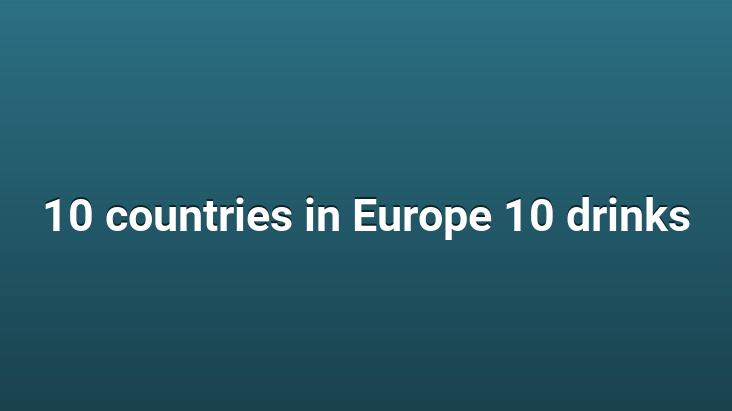Traveling to a country is not just about visiting tourist spots and taking pictures in front of famous buildings.. In order to get to know the culture of that region better, we need to add local flavors to our experience.. Of course, when we say local tastes, we should not only think of meals and desserts.. When we skip the alcoholic beverages that have been on our tables throughout history, we are disregarding an important legacy.. That’s why, in this article, I made a small list of local European drinks.. But this list is not “for beer in Germany, for wine in France”. All of them are unique to that country and most of them are not easily found in Turkey.. If you happen to be in one of these countries, “What can we drink special here?” Remember me when you think
EUROPEAN BEVERAGES
1. Poland / Bison Grass Vodka (Bison Grass Vodka)
Excellent Polish drink whose fame has crossed borders and has brought a different dimension to vodka.. The biggest feature of this vodka, whose Polish name is Zubrovka, is that it contains bison grass, as the name suggests.. Vodka contains both the essence of the grass and the cut one or two branches.. Bison grass, which is abundant in the forested areas in the north of the country, is also considered as a medicinal drink due to its blood thinning properties.. Its history is quite old; at first 8. It is not clear who produced Zubrovka, which is estimated to have been produced in the 19th century; Could be Russians or Poles.. But its popularity. It became one of the country’s trademarks because it won together with the Poles in the 19th century.. Legend has it that farmers and foresters drink a shot of Zubrovka every morning to get strong like a bison.
How to drink Zubrovka? Usually chilled in the freezer still drinking dry. If you want to dilute it, your best friend is apple juice.. What makes Zubrovka the perfect vodka is that the “morning after effect” is zero no matter how much you drink it.. That’s why, in my eyes, it leads the list of European spirits.
2. Italy / Grappa
Italy’s local drinks are quite plentiful.. For example, we should not forget Limoncello, but this time I will talk about Grappa, the registered grape raki of Italians.. History 13. The production of the modern version of Grappa, which dates back to the 19th century, started in 1979 in Northern Italy.. Northern Italy is the place where it is consumed the most.. It is said that he drinks Grappa constantly to cope with the cold coming from the Alps in winter.. In addition, a shot of Grappa with the meal Grappa it is possible to see it on Italian tables because it helps digestion.
How to drink Grappa? When you go to Italian cafes, you don’t know what’s on the menu. you will see many types of espresso. There is another type of coffee as common as Macchiato and Americano in Italy: Corretto.. Here’s that Corretto with a shot of espresso and Grappa. So its common use is with coffee.. It is usually drunk on an empty stomach on cold winter days.. If you’re going to drink it after your meal, drink it straight. Is it beautiful? I think not, but it’s worth a try.
3. Czechia / Becherovka
In recent years, Prague has become a very popular tourism city, as it offers a cheap holiday option.. Therefore, the number of people who know Becherovka has increased rapidly.. So much so that it is now possible to find it in Turkey.. For those who don’t know, let’s talk briefly; Becherovka is a Czech liqueur containing around 30 herbal extracts and spices, with a consistency that could be sold in our herbalists without alcohol.. The legend of Coca Cola also applies to this drink.. Only two people know the formula The history of this drink is 18. goes back to the century. The Czech city of Karlovy Vary, famous for its hot springs, is the origin of Becherovka. If you happen to come here, you can find more detailed information in the “Jan Becher Museum”.
How to drink Becherovka? As you can imagine, the public naturally drinks it straight, they can even drink it without the need for cooling.. The lightening option is to mix it with tonic.. Different flavor options are also available.. My favorite is Becherovka with lemon. Just chill it in the freezer.
4. Spain / Cava
Cava, a Catalan drink that has an important place in Spanish culture. It is mainly produced in Catalonia.. Its first production is 19. yy made here. Although it is very similar in taste to sparkling wine and champagne, it differs from these two in terms of grape varieties used and production method.. They define it as “Production of wine by the champagne method.” Since sparkling wine is also very common in Spain, there is a high probability that you are drinking sparkling wine saying “I drink Cava”, so let me warn you in advance.
How to drink Cava? It is a drink like liqueur.. It is one of my favorites among European drinks.. It tastes like soda, you can find it at any time of the day, at any time, in any environment and drink it.. Sangrea made from Java is also very nice, I recommend you to try it when you go.
5. Slovakia / Tatratea
Slovakia’s local liqueur Tatratea is the most interesting European drink in my opinion.. The main ingredient of this liqueur, which is blended with herbal extracts from the Tatra mountains, is tea.. There are three main types: tea, fruit and herbal.. These also vary according to their alcohol content.. All in different colored bottles. The original product is Tatratea, which is mainly tea with a 52% alcohol content, in a black bottle.
How to drink Tatratea? Each type has different drinking methods. Fruit-based ones are easier to drink because they are both lighter and sweeter.. If we talk about its widespread use; put in hot tea or cooled and drunk straight. Its cocktails are also quite common across the country.
6. Belgium / Jenever
Considered the ancestor of today’s genie, Jenever, also used as “Genever”, is the pride of the Dutch. In fact, it is not only unique to Belgium, it is also widely used in the Netherlands, but the Belgians own it more, it even has a museum in Hasselt.. (Click for detailed information about the museum.) One of the oldest European drinks.. It is even bought for its authentic-looking bottle that looks like it is made of earth.
How to drink Jenever? It is usually served dry in bars in Belgium, it is drunk with a beer on the side.. I recommend this way because I always prefer gin with tonic.
7. Germany / Jagermeister
Although it is now among the European drinks that we can easily find and drink in our country, Germany is the holy land for Jagermeister. It winks at the Spice Bazaar from afar as it contains 56 kinds of herbal extracts, spices and fruits.. The taste is similar to Becherovka, only sweeter and more comfortable to drink. Especially when you drink it in winter, it makes you feel as if you are purified from all microbes in the body.
How to drink Jagermeister? Drinking it straight in a shot glass is the most common form of consumption.. It is also widely used in cocktails. His best friend is Red Bull.
8. Portugal / Ginjinha
Lisbon’s sweet cherry liqueur Ginjinha, a drink mostly consumed by locals. The liqueur, produced from a type of cherry called “Ginja fruit”, is sold in a tiny shop with the same name in Lisbon.. There are other places that are sold, of course, but think like Vefa Bozacisi, the most original one is in the place that bears its name.. Locals stop by here during the day and drink their liquor like they drink coffee and continue on their way.. Therefore, we can say that there is no time to drink Ginjinha. It’s a drink I can say “if you go to Portugal, don’t come back without drinking”.
How to drink ginjinha? Served as is in a tiny glass. If you wish, you can also put fermented cherries in it.
9. France / Absinthe
After its ban in France in 1914, the homeland of Absinthe is actually France, even though Czechia, which is the only country that is free to drink and produce, is its new owner.. 18. It was used and widespread especially in the treatment of infectious intestinal diseases in the 19th century.. It would be better if it was used only for therapeutic purposes, but of course, human beings do not know its limits.. Especially the bohemian cut has exaggerated the consumption of Absinthe. When claims to cause mental disorders due to high alcohol content became widespread, 20. Although it was banned in many countries in Europe at the beginning of the century, these prohibitions have gradually disappeared today.. It is said that the wormwood grass in it causes hallucinative effects if consumed excessively.. In the Czech version, there is a portrait of Van Gogh on the bottle because, according to a rumor, the famous painter lost consciousness and cut off his ear after drinking Absinthe.
How to drink Absinthe? Very good cocktails can be prepared with the low alcohol version of. However, its common use is to drink it by diluting it a little.. There is a metal spoon next to the bottle, especially from the touristic areas.. With the help of this spoon, you can melt the sugar into the drink and drink it that way.. I did not find it appropriate to explain in more detail
10. Hungary / Palinka
Astonishing Hungarian fruit liqueur. Why did I say that? Because, as we know, fruit liqueur is a drink that we can’t get enough of, we don’t know what kind of cocktail to use, and sometimes it even makes us faint because of excessive sweetness.. Palinka was one of the bitterest drinks I’ve ever had.. Available in banana, pear, peach and cherry flavors. Palinka also has a 500-year history. Hungarians drink it before meals to facilitate digestion.. Alternatively, there are those who drink it on top of the meal.
How to drink Palinka? It is served dry in small glasses.. If you take the bottle and drink it yourself at home, it makes more sense to mix it with a juice.. Frankly, I didn’t think of buying it after the bitter and dry experience I had.
Articles That Might Interest You
Don’t Be Back Without Trying: 10 Traditional Middle Eastern Drinks »
Monthly Recommendations : What Did I Discover in July? »
Food and Drink in Dubai: Venues and Prices »
Food and Drink in Prague: Venues and Prices »
How to Plan a Travel Abroad? »
If you like the article “10 Countries 10 Drinks in Europe”, you can subscribe to the e-mail group by filling out the form at the bottom of the page or follow my social media accounts to be updated about other articles.

